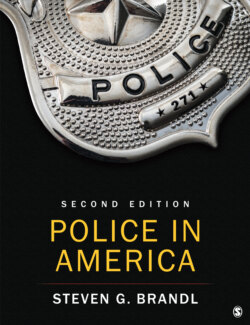Читать книгу Police in America - Steven G. Brandl - Страница 60
На сайте Литреса книга снята с продажи.
Technology on the Job
ОглавлениеThe Police Baton
Invented in the 1800s and first used in English police departments, the police baton was one of the few tools available to officers to assist them in controlling and arresting criminals. In its original form, the baton, also known as a billy club, sap, blackjack, or truncheon, was approximately twelve inches long, made of wood, and heavy. It was meant to be used as a striking instrument. There were few if any limits on how the club was to be used; most effective was when a subject was hit in the head and knocked unconscious. It was a relatively inexpensive weapon and easy to use. Over time, the baton was made longer and incorporated other features. As batons become longer, they became more difficult and cumbersome for police officers to carry. In the 1960s, the use of batons became synonymous with police brutality, and officers were frequently shown using batons on rioters.
Side handle batons, commonly known as PR-24s, were introduced in the 1970s and are still used in some police departments today. With the addition of a side handle, the baton became a more versatile tool that could also be used like a shield to protect from an attack. Collapsible batons, also called expandable or telescopic batons, were introduced to American police departments in the 1980s. In most police departments today, this type of baton is standard issue and is carried on the officer’s duty belt. For most models, when collapsed the baton is less than ten inches long and can expand up to thirty-one inches. It is extended with a forceful quick swing. These batons are made of metal and are lightweight.
While batons are still standard issue in U.S. police departments, they are very seldom used by officers in force incidents as their use often results in serious injuries to subjects.25
Photo 2.3 The wooden baton, sometimes knows as the billy club, was one of the first tools used by the police. Over time, the police baton became more technologically advanced. Today, most officers carry an expandable baton but seldom use it against subjects.
Shawn Patrick Ouellette/Portland Press Herald via Getty Images
It was also around this time that criminal identification systems began to be developed and used in police departments. The first of these systems involved photography. By 1858, the New York City Police Department had on file a collection of photographs of known criminals called a rogues gallery.29 However, photographs were extremely limited in their usefulness because the appearance of criminals could be altered either deliberately or simply by the aging process. Of course, for photographs to be useful, authorities first needed to know who committed a crime and then have a photograph of that person.
rogues gallery: A collection of photographs of known criminals.
The Bertillonage system was considered a major improvement over the use of photographs. The system consisted of eleven measurements (e.g., length and width of the head, length of the left foot, length of the left middle and little fingers) that could be used to differentiate one person from another.30 However, by the early 1900s, the deficiencies of the system were obvious. Besides being cumbersome and error prone, it had essentially no capabilities in identifying unknown offenders who committed crimes.
Bertillonage: A system wherein physical measurements were used to differentiate suspects.
In addition to these identification methods, detectives during this period also used various “investigative” tactics to deal with crime and criminals. One common strategy was the dragnet, which involved the police “rounding up the usual suspects.” The dragnet was often paired with the third degree—the brutal interrogation of suspects.31 The third degree included beatings with a rubber hose,32 placing a suspect in a sweat box for hours or days under constant questioning,33 drilling teeth, burning flesh with lit cigars or cigarettes, and beating with blackjacks or batons.34 Many accounts suggest that the use of the third degree to obtain confessions was commonplace into the 1930s and possibly even later.35 However, in 1936 the Supreme Court ruled in Brown v. Mississippi that prolonged beatings used to extract confessions were no longer a legally acceptable police practice.
dragnet: A historical reference to the process wherein when a crime occurred, the police would bring in for questioning all the suspects usually associated with that type of crime.
third degree: A historical reference to the physically brutal interrogation of suspects by police.
